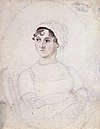Plan of a Novel, according to Hints from Various Quarters
Plan of a Novel, according to Hints from Various Quarters is a short satirical work by Jane Austen, probably written in May 1816.[1] It was published in complete form for the first time by R. W. Chapman in 1926, extracts having appeared in 1871.[2] It has been said that "in the Plan and the correspondence from which it arose, we have the most important account of what Jane Austen understood to be her aims and capacities as a novelist".[3]
Background
In October 1815 Austen was approached via letter by the Rev.
The correspondence between Austen and Clarke continued beyond their meeting at Carlton House. He had ideas for her fiction, including a novel to be based on a clergyman with a foothold in urban life, as well as the provincial rural settings she had used so far for clerics in her novels.
Content and humour of the Plan
The intention of the work was to set down the essential parts of the "ideal novel". Austen was following, and guying, the recommendations of Clarke.[1] The work was also influenced by some of Austen's personal circle with views on the novel of courtship, and names are recorded in the margins of the manuscript;[9] they included William Gifford, her publisher, and her niece Fanny Knight.[10]
The Plan became a sort of family joke among the Austens. Some of its aspects parody contemporary works by authors such as
References
- ISBN 1-85285-114-7.
Notes
- ^ ISBN 978-0-313-30017-2. Retrieved 4 September 2013.
- ISBN 978-1-4381-0849-0. Retrieved 4 September 2013.
- ISBN 978-0-8264-2592-8. Retrieved 4 September 2013.
- ^ a b c https://janeaustens.house/object/letter-from-jane-austen-to-james-stanier-clarke-1-april-1816/
- ISBN 9781559703871.
- ^ Austen wrote in a letter to Martha Lloyd on 16 February 1813 of the Prince's infidelities and his wife: "I am resolved at least always to think that she would have been respectable, if the Prince had behaved only tolerably by her at first."
- ^ Collins, p. 1.
- JSTOR 3661480.
- ISBN 978-0-8018-4970-1. Retrieved 4 September 2013.
- ^ ISBN 978-0-521-00757-3. Retrieved 4 September 2013.

